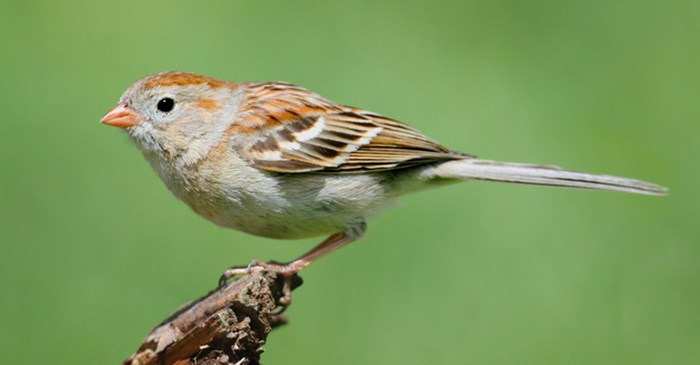What the Field Sparrow lacks in colorful plumage, it makes up for in its rich, "bouncing" songs — some liken its rhythm to that of a dropped ping-pong ball. It starts with a series of whistled notes finished off with a trill that gets faster and faster until it stops.
Finding the Field Sparrow
Field Sparrows are decked out in camouflaging brown and grays, with rust-colored caps, white eyeliner, and pink bills. Their year-round territory spans the East Coast, from Massachusetts to Northern Florida, westward to Central Texas. Look for Field Sparrows in open spaces with tall grasses, bushes and small trees. Because of their subtle colors and markings, it is easiest to locate these birds by sound rather than by sight. Early springtime mornings are the best time to catch the "extended version” of the Field Sparrow song.
Breeding and Nesting
Field Sparrows flock to the Northeastern part of the U.S. during breeding season. Male Field Sparrows will return to previous nesting sites during the breeding season. Listen for the male's arrival — he'll sing a vigorous song to attract a new mate. Don't be alarmed if you see a male Field Sparrow "attack" a female and knock her to the ground, it's just part of this sparrow's unusual courtship ritual.
Field Sparrows frequently nest more than once a season, building a new nest each time. Each time they build a new nest, they choose a spot higher off the ground than the previous one.
Winter Territory
Once breeding season is over, the Field Sparrow may join mixed feeding flocks with other sparrow species. Together they'll travel to the species' winter territory, which covers an area that stretches from the deep south, up to the lower Midwest and New England.
Backyard Tips
Field Sparrows are common backyard feeders. They’re easy to please, favoring hulled sunflower seeds and cracked corn. Fill your feeders with Lyric Supreme Mix, and you’ll be sure to draw a flock of Field Sparrows and many other species year-round.
